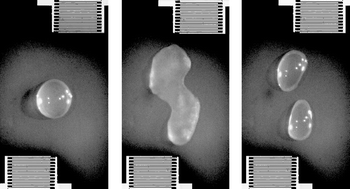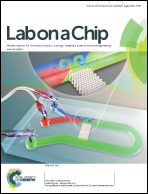Planar microfluidic drop splitting and merging
Abstract
Open droplet microfluidic platforms offer attractive alternatives to closed microchannel devices, including lower fabrication cost and complexity, significantly smaller sample and reagent volumes, reduced surface contact and adsorption, as well as drop scalability, reconfigurability, and individual addressability. For these platforms to be effective, however, they require efficient schemes for planar drop transport and manipulation. While there are many methods that have been reported for drop transport, it is far more difficult to carry out other drop operations such as dispensing, merging and splitting. In this work, we introduce a novel alternative to merge and, more crucially, split drops using laterally-offset modulated surface acoustic waves (SAWs). The energy delivery into the drop is divided into two components: a small modulation amplitude excitation to initiate weak rotational flow within the drop followed by a short burst in energy to induce it to stretch. Upon removal of the SAW energy, capillary forces at the center of the elongated drop cause the liquid in this capillary bridge region to drain towards both ends of the drop, resulting in its collapse and therefore the splitting of the drop. This however occurs only below a critical Ohnesorge number, which is a balance between the viscous forces that retard the drainage and the sufficiently large capillary forces that cause the liquid bridge to pinch. We show the possibility of reliably splitting drops into two equal sized droplets with an average deviation in their volumes of only around 4% and no greater than 10%, which is comparable to the 7% and below splitting deviation obtained with electrowetting drop splitting techniques. In addition, we also show that it is possible to split the drop asymmetrically to controllably and reliably produce droplets of different volumes. Such potential as well as the flexibility in tuning the device to operate on drops of different sizes without requiring electrode reconfiguration, i.e., the use of different devices, as is required in electrowetting—therefore makes the present method an attractive alternative to electrowetting schemes.



 Please wait while we load your content...
Please wait while we load your content...